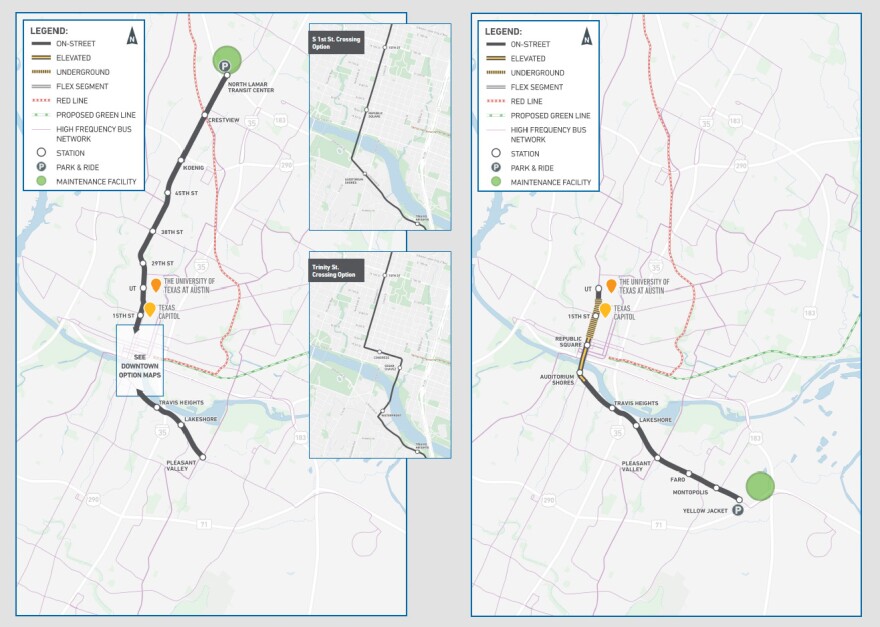After decades of failed efforts to bring light-rail to Austin, the city is on the verge of choosing where rapid rail should be routed — a contentious decision fraught with tradeoffs. The public comment period ends Tuesday at 11:59 p.m. for five new light-rail options proposed by the Austin Transit Partnership.
Each option is shorter and features fewer stations than the original plan approved by voters in 2020. Budget constraints also canceled a downtown subway still depicted on the Project Connect website as an underground public space with shopping, dining and live music.
Despite the diminished routes, all five plans would establish a light-rail starter system with room to keep stretching the lines further in the coming decades. This first phase is expected to be complete in the early 2030s.
Over the past six weeks, officials with the ATP spoke with thousands of people at bus stops, parks, churches and community meetings to explain the five options and answer questions.
"We've been really invested in making sure we're having a dialogue with the community," ATP Executive Director Greg Canally said. "We want to make sure that all of Austin is listening to what the other parts of Austin are saying."
People examining the light-rail options have a lot to consider. Should the trains cross Lady Bird Lake at South First Street or should the route travel deeper through downtown and cross the lake at Trinity Street? Should light-rail go all the way to the airport at the expense of higher ridership? Should the tracks be elevated downtown to bypass traffic if it means a shorter initial route?

ATP will compile the community feedback into a report to be published in mid-May. A final recommendation for the light-rail path will be presented in early June to the three governing bodies that oversee Project Connect: the ATP board, the Austin City Council and CapMetro's board of directors.
Canally, in an interview with KUT, wouldn't rule out the possibility that the final recommendation could be a remix of the existing options.
"ATP will always be open to a new wrinkle or a new twist on something that we put out there if it is for the betterment of Austin," Canally said. "We're in listening mode."
The ATP has faced some criticism for how it's handled the public comment process.
Tony Elkins, a transportation finance expert who resigned from ATP's board of directors last month, said the organization should have been more clear about which options are more likely to receive federal funding. The ATP is hoping the Federal Transit Agency will pay for up to half the costs of building light-rail in Austin.
"The risk of getting federal dollars is a critical determinant in which of the five options the public should select," Elkins told KUT.
Elkins was most concerned about each plan's cost per average daily rider. The FTA considers this cost-effectiveness metric in deciding who wins highly competitive grants.
For example, the route with the highest ridership — North Lamar to Pleasant Valley — would have an estimated 39,300 average daily riders by 2040. That's almost twice as cost-effective as the UT to Yellow Jacket line, which would have a projected 20,000 average daily riders by the same year.
"By being agnostic to that metric, we're not managing the public's perception of what we can get," Elkins said.

Meanwhile, some die-hard transit supporters have grown frustrated by the ATP's slow release of granular data that would allow for a closer analysis of the proposals.
The ATP for weeks resisted calls — including from elected officials — to release data that informs the ridership estimates for each option. On Friday night, with just days left in the public comment period, the ATP posted an FAQ about ridership estimates and announced a new data portal.
"We need a little bit more information to trust but verify," said Julio González Altamirano, a longtime transit advocate and data analyst.
Altamirano said more transparency and data availability could help the public and policymakers ensure the best decisions are being made about where to route the lines.
"This is a critical moment," he said. "Ten years from now, 20 years from now, these little choices will be so significant."
The chosen light-rail plan would also have to be politically popular enough to withstand an election, because a vote is looking increasingly likely this November. A bill that would require ATP to get voter-approval to issue bonds is being fast-tracked through the Texas Legislature with the help of Democrats.
Austin Mayor Kirk Watson is lobbying for the bill to get passed by a two-thirds majority so it would take effect immediately and an election could happen as soon as possible.
"Our objective is to ensure that Austin Light Rail is built on a solid foundation for the future," Watson wrote in his weekly newsletter. "The Legislature has the power to force another vote, but the ultimate power lies with the people of Austin."
ATP plans to borrow about $1.75 billion by issuing bonds and taking out loans from the U.S. Department of Transportation's Build America Bureau. If voters deny ATP the power to issue bonds, the light-rail system would be thrown in jeopardy because it would become virtually impossible to pay for the large upfront costs.
The public can review the plans and leave comments at the ATP's virtual open house.














